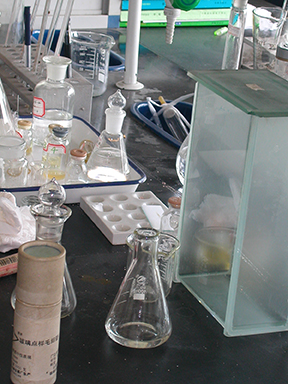
A lab in a Chinese Hospital clinic
By Richard Hammerschlag, Ph.D.
Co-Author, Acupuncture Efficacy
The principles and practice of acupuncture gradually developed in China at a time when individual practitioners’ experience driven by the question “Does it work?” shaped the evolution of the medicine. The same can be said for much of the development of Western medicine. But the post World War II rise of the pharmaceutical industry in the U.S. and Western Europe played a major role in changing the standard for acceptance of new medical practices. A new drug as well as a new surgical technique, and soon, any treatment from a growing list of “alternative” “unconventional,” or “complementary” medical practices was required to meet strict criteria of what has come to be called “evidence-based medicine”. The question “Does it work?” took on a different meaning when “evidence” was defined as the successful outcome of a clinical trial rather than treatment effectiveness in office-based practice. “Does it work?” means, in brief: “Has the treatment performed better than a placebo (a mock treatment) under conditions where the patients, and ideally also the physicians administering the treatment, did not know who received the real treatment and who received the placebo.”
A major consequence of this new standard of acceptance is that, in enlightened arenas of Western medicine, the playing field has been leveled for health care treatments lining-up to pass muster. An editorial in a special issue of J.A.M.A .on complementary and alternative medicine stated simply:
“There is no alternative medicine. There is only scientifically proven, evidence- based supported by solid data, or unproven medicine, for which scientific evidence is lacking. Whether a therapeutic practice is “Eastern” or “Western,” unconventional or mainstream, or involves mind-body techniques or molecular genetics is largely irrelevant except for historical purposes and cultural interest.” [J.A.M.A .280:1618-9, 1998]
These standards were applied directly to acupuncture at the 1997 National Institutes of Health Consensus Conference, which concluded with the panel’s endorsement that:
“There is sufficient evidence of acupuncture’s value to expand its use into conventional medicine and to encourage further studies of its physiology and clinical value.” [JAMA 280:1518-1524, 1998]
The past 20 years have witnessed an increasing effort to test acupuncture by the same clinical trial standards used in the screening of potential treatments in western medicine. As the quality of research design has increased, so has the list of conditions for which acupuncture has been found to outperform either placebo treatment or needling at inappropriate sites. While the predominant number of trials continues to be in the area of pain relief, studies have also been performed demonstrating effectiveness of acupuncture for treating conditions involving cardiovascular, gastrointestinal and immunological dysfunction. In addition, direct measurements of such biological markers as endorphins, hormones, blood flow, and brain function have begun to provide an understanding of how acupuncture exerts physiological changes.
For what common conditions has acupuncture been scientifically proven to be effective?
Migraine, dysmenorrhea (painful periods) and osteoarthritis are among a growing list of conditions for which acupuncture has been demonstrated, in controlled clinical trials, to be of benefit. In several of these trials, those patients who received acupuncture treatment were still experiencing symptom relief and using less pain medication when examined at one-year follow-up.
Has acupuncture been shown to be more effective than a placebo?
Although placebo acupuncture is not as easy to create as is a placebo drug, numerous procedures have been tried as acupuncture placebos. Patients with post-operative dental pain who were treated with acupuncture needles inserted through thin plastic guide tubes experienced significantly greater pain relief than did similar patients “treated” with empty plastic guide tubes. This placebo treatment was scientifically validated since all patients had gauze pads placed over their eyes and they were not able to correctly guess whether they had been treated with acupuncture or placebo. In the migraine and dysmenorrhea studies referred to above, as well as in a study of fibromyalgia, patients needled at true acupuncture points experienced significantly greater symptom relief than did patients treated with the same number of needles at non-acupoint sites.
Has acupuncture been compared to Western medical standard care?
When acupuncture is compared to a standard treatment, it usually has to be only at least as effective as the standard care to be considered as a potentially useful treatment option. Acupuncture was found as effective as a medication (a b -blocker) for migraine relief and as effective as an analgesic for reducing pain and discomfort of renal colic (kidney stones). In both studies, acupuncture produced markedly fewer side effects than the medication. Acupuncture can also produce effective complementary or adjunctive care. Recovering stroke patients who received acupuncture in addition to physical therapy recovered more rapidly and to a greater extent than did patients treated with physical therapy alone.
How does acupuncture work?
Acupuncture effectiveness for pain relief has been correlated by several experimental approaches with release of endogenous opioids (endorphins). Drugs that block morphine action also inhibit acupuncture analgesia. The discovery that different frequencies of electro-acupuncture release different classes of endorphins in the body led to the design of electro-acupuncture devices that automatically switch back and forth between high and low frequencies to maximize the level of pain relief. Acupuncture also stimulates blood flow and enhances immune system function. Very recently, functional magnetic resonance imaging (fMRI) of the brain has revealed that acupuncture stimulation of points on the leg or foot, that are traditionally used to treat eye or ear disorders, increases brain activity in regions of the visual cortex or the auditory cortex, respectively.
